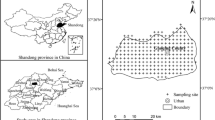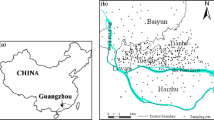Abstract
Dongguan City, located in the Pearl River Delta economic zone of China, is famous for its rapid developing township-enterprises in the past 30 years. A total of 759 composite soil samples, including 606 surface soil samples and 153 deep soil samples, have been collected in the city. These samples have been analyzed for 13 elements (Al, As, Cu, Cd, Co, Cr, Fe, Hg, Mn, Ni, Pb, Si, and Zn) and other parameters (pH values and organic matter) to evaluate the influence of anthropic activities on the soil environmental quality and to identify the spatial distribution of heavy metals and their possible sources. The results indicate that the average concentrations of heavy metals in soil were significantly lower than the threshold of the second grade of the Soil Environment Quality Standard in China (GB15618-1995) and the soil environmental quality in this area is comparatively good. But in comparison with local soil geochemical baseline values, As, Cd, Cu, Hg, Pb, and Zn have accumulated remarkably. Specifically, the average concentrations of As, Cd, Cu, and Hg in the small part samples of the west plain and central areas are higher than the national second-grade quality standard, indicating some level of contamination. Multivariate and geostatistical methods have been applied to differentiate the influences of natural processes and human activities on the concentration of heavy metals in surface soils in the study area. Cluster and factor analyses result in the grouping of Al, As, Cr, Cu, Fe, Ni, and Si into factor F1; Co, Mn, Pb, and Zn into F2; and Cd and Hg into F3. The spatial pattern of the three factors may be well demonstrated by geostatistical analysis. It is shown that the first factor could be considered as a natural source controlled by parent material. The second factor could be referred to as “industrial and traffic pollution sources”. The source of the third factor is mainly controlled by long-term anthropic activities, including agricultural activities, fossil fuel consumption, and atmospheric deposition.





Similar content being viewed by others
References
Baranowska I, Barchanska H, Pyrsz A (2005) Distribution of pesticides and heavy metals in trophic chain. Chemosphere 11:1590–1599
Bureau of Statistics of Dongguan (2005) Dongguan City statistical year book, 2004. China Statistics Press, Beijing, p 190 (in Chinese)
Cai L, Ma J, Zhou Y, Huang T, Dou L, Zhang C, Fu S (2008) Multivariate geostatistics and GIS-based approach to study the spatial distribution and sources of heavy metals in agricultural soil in the Pearl River Delta, China. Environ Sci 12:3496–3502 (in Chinese with English Abstract)
Chen T, Wong J, Zhou H, Wong M (1997) Assessment of trace metal distribution and contamination in surface soils of Hong Kong. Environ Pollut 1:61–68
China Geological Survey (CGS) (2006) Compilation of criterion for geological survey, fascicule of geochemical exploration. Unpublished book
China Geological Survey (CGS) (2011) Multi-purpose regional geochemical atlas of Pearl River Delta Economic Zone of Guangdong Province, People’s Republic of China
De Temmerman L, Vanongeval L, Boon W, Hoenig M, Geypens ME (2003) Heavy metal content of arable soils in Northern Belgium. Water Air Soil Pollut 1–4:61–76
Facchinelli A, Sacchi E, Mallen L (2001) Multivariate statistical and GIS-based approach to identify heavy metal sources in soils. Environ Pollut 3:313–324
Gallego JLR, Ordonez A, Loredo J (2002) Investigation of trace element sources from an industrialized area (Aviles, northern Spain) using multivariate statistical methods. Environ Int 7:589–596
Gao L, Guo J, (2003) An analysis on the Pearl River Delta Region by Guangdong Provincial Department of Construction. Guangdong Construction Information 6, p 18 (in Chinese)
GB15618-1995 (1995) Soil environmental quality standards in China, Standards Press of China, Beijing (in Chinese)
Ikingura JR, Akagi H, Mujumba J, Messo C (2006) Environmental assessment of mercury dispersion, transformation and bioavailability in the Lake Victoria Goldfields, Tanzania. J Environ Manag 2:167–173
Kober B, Wessels M, Bollhofer A, Mangini A (1999) Pb isotopes in sediments of Lake Constance, Central Europe constrain the heavy metal pathways and the pollution history of the catchment, the lake and the regional atmosphere. Geochim Cosmochim Acta 9:1293–1303
Kuo TH, Chang C, Urba A, Kvietkus K (2006) Atmospheric gaseous mercury in Northern Taiwan. Sci Total Environ 1:10–18
Linak WP, Wendt JO (1994) Trace metal transformation mechanisms during coal combustion. Fuel Process Technol 1–3:173–198
Liu W, Li X, Shen Z, Wang D, Wai Q, Li Y (2003) Multivariate statistical study of heavy metal enrichment in sediments of the Pearl River Esturary. Environ Pollut 121:377–388
Liu X, Xu J, Zhang M, Zhou B (2004) Effects of land management change on spatial variability of organic matter and nutrients in paddy field: a case study of Pinghu, China. Environ Manag 5:691–700
Manta DS, Angelone M, Bellanca A, Neri R, Sprovieri M (2002) Heavy metals in urban soils: a case study from the city of Palermo (Sicily), Italy. Sci Total Environ 1–3:229–243
Mantovi P, Bonazzi G, Maestri E, Marmiroli N (2003) Accumulation of copper and zinc from liquid manure in agricultural soils and crop plants. Plant Soil 2:249–257
Mukherjee AB, Zevenhoven R (2006) Mercury in coal ash and its fate in the Indian subcontinent: a synoptic review. Sci Total Environ 1:384–392
Mukherjee AB, Zevenhoven R, Bhattacharya P, Sajwan KS, Kikuchi R (2008) Mercury flow via coal and coal utilization by-products: a global perspective. Resour Conserv Recycl 4:571–591
Nakagawa R, Hiromoto M (1997) Geographical distribution and background levels of total mercury in air in Japan and neighbouring countries. Chemosphere 4:801–806
Nicholson FA, Smith SR, Alloway BJ, Carlton-Smith C, Chambers BJ (2003) An inventory of heavy metals inputs to agricultural soils in England and Wales. Sci Total Environ 311(1–3):205–219
Rodriguez MJ, Arias ML, Grau CJ (2006) Heavy metals contents in agricultural topsoils in the Ebro basin (Spain). Application of the multivariate geoestatistical methods to study spatial variations. Environ Pollut 3:1001–1012
Wang D, Shi X, Wei S (2003) Accumulation and transformation of atmospheric mercury in soil. Sci Total Environ 1–3:209–214
Webster R, Oliver MA (2001) Geostatistics for environmental scientists. Wiley, Chichester, pp 37–103
Xie S (2003) A study on resources and environment and sustainable development strategy of the Pearl River Delta. Territ Nat Resour Study 4:41–43 (in Chinese with English Abstract)
Zheng N, Wang Q, Zhang X, Zheng D, Zhang Z, Zhang S (2007) Population health risk due to dietary intake of heavy metals in the industrial area of Huludao city, China. Sci Total Environ 1–3:96–104
Zheng J, Ou J, Mo Z, Yin S (2011) Mercury emission inventory and its spatial characteristics in the Pearl Delta region, China. Sci Total Environ 412–413:214–222
Zhou G, Xie X, Liu Z, Chen M, Zhang Q, Fan H (2004) Potential ecological risk assessment of heavy metal in soils in the Zhujiang River delta: heavy metal activation in Soils. Geol Bull China 11:1088–1093 (in Chinese with English Abstract)
Zhu Y, Chen B, Lin A, Ye Z, Huang M (2005) Heavy metal contamination in Pearl River Delta—status and research priorities. Acta Scientiae Circumstantiae 12:1575–1579 (in Chinese with English Abstract)
Acknowledgments
This work was supported by the China Geological Survey Project (1212010511216) and Environmental Protection Special Foundation of Guangdong Provincial (Guangdong Environment [2014]126). We also would like to thank the anonymous reviewers for their valuable comments and suggestions to improve the quality of the paper.
Author information
Authors and Affiliations
Corresponding author
Rights and permissions
About this article
Cite this article
Dou, L., Shen, SZ. & Du, HY. Distributional characteristics and sources of elements in soil from typical area of Pearl River Delta economic zone, Guangdong Province, China. Chin. J. Geochem. 34, 299–310 (2015). https://doi.org/10.1007/s11631-015-0048-4
Received:
Revised:
Accepted:
Published:
Issue Date:
DOI: https://doi.org/10.1007/s11631-015-0048-4




